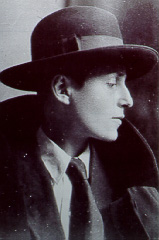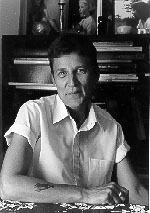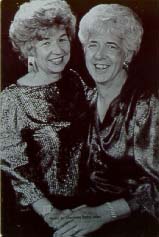How Many Sexes? How Many Genders?
When Two Are Not Enough
by
Aaron H. Devor, Ph.D.
Sociology Department
University of Victoria, Canada
How Many Sexes? How Many Genders?
When Two Are Not Enough
TABLE of CONTENTS
Abstract
Introduction
Sex
Intersex People
Gender
Trans and Non-Binary People
An Extremely Abbreviated and Simplified History of Sex & Gender
Gender Blending: Confronting the Limits of Duality
The Ideology of the Dominant Gender Schema
The Gender Attribution Process
Some Gendered Sexuality Definitions
Three Examples of Gendered Sexuality
FTM: Female-to-Male Transsexuals in Society
Concluding Comments
Abstract
Approximately a decade of my research with trans and non-binary people is summarized in order to explore and illustrate some of the limitations in dualistic conceptualizations of gender, sex, and sexuality. In the process, I argue that increased descriptive power may be gained through the use of greater subtlety and nuancing of binary concepts of gender, sex, and sexuality. However I maintain that, ultimately, the dualistic paradigm is being stretched to the breaking point by the challenges raised by trans and non-binary people and that it is time for the development of new modes of thought.
Introduction

Amazon Monkey
Photo © Aaron Devor
Most people have begun to come to an awareness of the profound importance of biodiversity for the survival of our planet. We have begun to grasp the idea that we cannot go on forever eliminating species of plants and animals from the face of the earth and expect our planet to survive. Unfortunately, we have been very slow to generalize this concept to our understandings of gender, sex, and sexuality. We tend to continue to think of people whose genders, sexes, or sexualities are unusual as “mistakes” of either nature or of nurture. Our dogged insistence on thinking in terms of binary categorizations of male/female, man/woman, heterosexual/homosexual, either/or, right/wrong, serves to blinker our vision. It is time that we begin to recognize that there are far more “mistakes of society” than there are “mistakes of nature,” and to begin to retool ourselves for the job of coming to see, appreciate, and understand the value of human gender sex, and sexual diversity.
It has been in the process of conducting research with trans and non-binary people that I have learned to see things differently. I have studied trans and non-binary people because I want to understand how gender functions in society at large and I have followed a research tradition in sociology which argues that one of the better ways to understand the rules of society, is to study those people who break them. In so doing, I have learned a great deal from people who, often with great difficulty and with only moderate success, try to fit themselves into the simplistic notions of gender, sex, and sexuality which dominate the thinking in society at large.
However, before I begin my discussion of what I have learned from my studies I would like to clarify for you some of the terms which I will be using.
SEX
A social status usually based on genital appearance.
Persons may be female, male, or intersex.
When I use the term sex, I refer to persons’ biological statuses as female, male, or intersex. Sex statuses are usually assigned by doctors on the basis of visual inspection of the genitalia of newborns. However, when genitalia are inconclusive, persons’ sexes can be determined on the basis of chromosomes.
INTERSEX
A social status assigned to persons having sex characteristicss of both females and males.
Persons may be female, male, or intersex. Intersex people are those who have sex characteristics of both females and males. The precise criteria and numbers of categories used in such determinations are historically and culturally variable. A point to which I will return shortly.
GENDER
A social status usually based on the gender identity and gender expression.
Persons may be women or girls, boys or men, who are cisgender, trans, or non-binary.
When I use the term gender, I refer to persons’ social statuses as women, girls, men, boys. They may be cisgender or trans, or non-binary. In contemporary North American societies, genders are generally assumed to be direct social manifestations of persons’ sexes. However, when I use the term gender, I do not share that assumption. Rather, when I call people women, men, trans, or non-binary, I assume only that their gender identiies and gender expression make them recognizable as women, men, trans, or non-binary. I do not assume anything about their sexes without further information. People whose gender identity matches the one assigned at birth are cisgender. People whose gender identity is different from the one assigned to them at birth are trans, or non-binary.
TRANS AND NON-BINARY PEOPLE
Trans and non-binary people feel that they do not fit well as women or men. They may feel themselves to be neither gender, to be both genders, or to be a gender other than what their sex would normally dictate. Persons may be trans or non-binary on the basis of only their feelings about themselves, they may appear ambiguously gendered to others, or they may change their gender and live unnoticed as another gender.
The terms trans and non-binary are still evolving. They are used in a variety of ways by a variety of people. Trans and non-binary people usually feel that they do not fit perfectly as either women or men. They may feel themselves to be neither women or men, to be both women and men, to be a gender other than what their sex would normally dictate, or to be outside of gender altogether. Persons may be trans or non-binary on the basis of only their feelings about themselves, they may appear ambiguously gendered to others, or they may change genders and live unnoticed as another gender.

King Tut-ankh-amen
An Extremely Abbreviated
and
Simplified History
of
Sex & Gender
and
Simplified History
of
Sex & Gender

Amenophis IV
Intersex and gender-diverse people have been among us as long as human beings have existed. They appear in ancient history, myths, and tales of many cultures. Indeed, an older word for intersex, hermaphrodite, comes from ancient Greek lore. According to legend, the god Hermes (known as Mercury among the Romans) mated with the goddess Aphrodite (known as Venus among the Romans). Together they begat a son, Hermaphroditus, who, at the age of 15, so fell in love with a nymph that his body fused with hers and he became intersex.

Hermaphroditus
Throughout Western history, intersex persons have been recognized as a having a sex intermediate between female and male. Hippocrates, Aristotle, Galen, and the authors of the Talmud all made reference to intersex people as a taken-for-granted kind of human sex variation. European cultures of the middle ages and the Rennaisance followed in the same tradition of acceptance of intersex individuals as natural variants of the more usual female and male sexes.

Les Hermaphrodites ~ A 16th
century treatise on hermaphrodites
During these many centuries, Western thought was dominated by the belief that there was only one sex, which might come in three levels of perfection. The optimum physical form was male. Females and intersex people were believed to be sub-standard humans who had fallen short of maleness. Furthermore, tremendous social status hinged on one’s gender. Therefore, trans and non-binary gender expressions were not well tolerated. All persons, including intersex persons, were required to live as only one gender throughout their entire lifetimes and the penalties for gender transgressions during this period were severe, and often fatal. Nonetheless, stories survive of many persons who lived gender-diverse lives.

Catalina de Erauso, 1600
A Spanish conquistador

Magdalena Ventura with her
husband, 1631
Artist: Jusepe de Ribera

Lord Cornbury, 1700s
Things changed somewhat by the time of the Enlightenment. By approximately the year 1800, medical and legal opinion had shifted to the modern idea that females and males constitute two entirely different sexes rather than variations on a single sex. Intersex people began to be seen as defective females or males rather than a third variation in their own right. Genders came to be assumed to be natural outgrowths of sexes. However, during the 18th century, four genders began to be recognized in some European societies: feminine women and masculine women, and feminine men and masculine men. Those who crossed genders were assumed also to be intersex. Although there could be stigma attached to such gender crossing, many gender-diverse people enjoyed considerable fame and fortune.

Chevalier d’Eon, the young woman

Chevalier d’Eon, the man

Chevalier d’Eon, the old woman
For example: Lord Cornbury, colonial governor of NY and NJ from 1702-1708 was reputed to have often attended to political duties dressed as a woman. Similarly, the Chevalier d’Eon had a long and distinguished career as a spy and a diplomat. D’Eon’s sex was hotly debated throughout Europe for many years. James Gray, a.k.a Hannah Snell, served in the British military and later became admired and renowned for bravery. Anne Bonny & Mary Reed were infamous female pirates of their day. They lived openly gender nonconforming lives in defiance both of the law and of all social conventions.

James Gray aka
Hannah Snell

Anne Bonny

Mary Reed
During the 19th and early parts of the 20th centuries the idea that genders must be indelibly wed to particular types of bodies became more firmly established. Intersex individuals continued to exist but became more and more hidden as medicine further pronounced them be defective human beings. However, gender diverse people continued to find ways to express their gender identities. The 1920s was a particularly heady time of increased freedoms for females and some gender-diverse females seemed to have availed themselves of that opening. Colonel Victor Barker/Valerie Arkell-Smith fought in the British military. Gluck, born Hannah Gluckstein was a successful English artist. Jane Heap was an upper class British intellectual.

Colonel Victor Barker
aka Valerie Arkell-Smith

Hannah Gluckstein

Jane Heap
During the first half of the 20th century two medical developments transpired which were of great significance for intersex, trans, and non-binary people: Firstly, advancements in the field of endocrinology enabled the manipulation of sex hormones. Secondly, increased public acceptance of cosmetic plastic surgery paved the way for the alteration of sex characteristics in order to alleviate psychological distress. By the 1950s, these developments led both to the routine surgical alteration of genitalia and to the adjustment of the hormones of intersex people to make them appear more fully female or male. This was, and still is, often done to infants and young children well before they reach the age of consent. Furthermore, these developments also led to the possibility of the partial satisfaction of the demands of trans and non-binary people that their bodies should be made more commensurate with their gender and sex identities. It was in this context of the enforced invisibility of intersex people and the increasing visibility of trans and non-binary people that I began my work.
Gender Blending:
Confronting the Limits of Duality
Confronting the Limits of Duality

In the early 1980s, I began the research for my book Gender Blending: Confronting the Limits of Duality. In that work, I set out to study a few people out of a non-binary population I dubbed as “gender blending females”. They were people who may be of any sexual orientation and who have clear self-identities as biological females and as women. They dressed and moved in ways which are not stereotypically feminine but did not try to appear to be men or boys. Often, to their own consternation, they were not always successful at communicating their identities to other people who came into casual contact with them. Among their friends and acquaintances, and to many strangers, they were clearly women. Yet, they were often taken to be men when dealing with people who were meeting them for the first time.

Sunny
Photo © Aaron Devor

Lauri
Photo © Aaron Devor

Heather
Photo © Aaron Devor
For the purposes of my book, Gender Blending, I interviewed 15 gender blending females about their experiences of being mistaken for boys or men. All but one of them had experienced this situation for more than five years. All but three of them were mistakenly thought to be men or boys on an everyday basis, to the point where they no longer automatically expected to be recognized as women by strangers. I learned a number of important things from talking with these women. I learned that there were both advantages and disadvantages to their gender situations. On the plus side, they were able to sporadically and temporarily avoid some of the stigma often associated with being female in a patriarchal society, and to gain access to some of the privileges normally reserved for men. Although they enjoyed being given preferential treatment in their dealings with clerks, waiters, and the like, of far greater importance to them was the safety factor. Those gender blending females who moved through public spaces with confidence that they would be assumed to be men gained a freedom of movement which few women can even imagine.
As one woman said: I was walking down the street and men were looking me straight in the eye with this incredible amount of respect. I didn’t know what … was going on. … Like it was totally different, and I said … “This feels like being in another world, it was like being a human being.” I couldn’t believe the sensation. What a power trip! It was wonderful! So I started to learn, hey, if I looked like a guy no one is going to hassle me. (Anon.)
However, there were also some fairly major disadvantages. The largest problem was that these women could not find ways for them to remain true to themselves as non-feminine women and still fit into a society which allowed them limited readily intelligible gender options. One woman’s stories illustrated some of the long-term implications of feeling like such a misfit:
[In the beginning] It wasn’t that regular, but it would surprise me when I would go to my own bank and they would say to me, “Yes, sir?” … My first response was that I didn’t know who they were talking to. And then after I realized that they were talking to me, mostly I just thought, “How strange?” … I thought, “Well, you stupid asshole, what’s the matter with you?” … Usually I was so nonplussed that I wouldn’t even bother to correct them. (Anon.)

Ruth
Photo © Aaron Devor
… When it first started to happen regularly, like every day, I started to take it on. Like I was a freak, and I had to learn to live my life as a freak. Something that everybody could stare at whenever they wanted to, and comment about whenever they wanted to. … Well, if they thought I was a man from beginning to end, then I wasn’t a freak. The freak was in the mistake. So I didn’t correct them. I just sort of shrunk a little bit inside of myself, but I didn’t correct them. (Anon.)
The effect that this strategy had on this woman was debilitating.
There was quite a long time there when I wasn’t regularly employed, and I didn’t go out of the house. Because … sometimes I’d feel so fragile that I would feel that I couldn’t cope with it if it would happen one more time, so I just wouldn’t go out. This series of mistakes, over and over again, has really altered the way I deal with the world. (Anon.)
More broadly, I learned some important lessons about the social construction of gender and sex. I learned that we are taught to think about gender and sex in one way, whereas when we actually deal in gender and sex in everyday life, we understand them according to a different set of unspoken rules.
First, a synopsis of the way we are taught to think about gender and sex, I call these rules the “dominant gender schema.” These are learned social beliefs. Not everyone agrees that they are all true, especially me, but they are widely believed to be true and, as such, generally carry the weight and moral authority of descriptions of “reality.”
1) Sex is an intrinsic biological characteristic. There are two and only two sexes: male and female.
2) All persons are either one sex or the other. No person can be neither. Normally, no person can be both. No person can change sex without major medical intervention.
3) Genders are the social manifestation of sex. There are two and only two genders: men and women, (boys and girls). All males are either boys or men. All females are either girls or women.
4) All persons are either one gender or the other. No person can be neither. No person can be both. No person can change gender without major medical intervention.
5) Gender role styles are culturally defined expressions of sex and gender. There are two main gender role styles: masculinity and femininity. Most males are masculine men. Most females are feminine women.
6) Many persons do not exactly fit their expected gender roles. This is due to imperfect socialization or psychological pathology.
7) By virtue of evolutionary selection processes, those persons who are males, boys, or men deserve greater social status, authority and power than those who are females, girls, or women.
Furthermore, I learned that, in everyday life, we actually recognize persons’ genders on the basis of their gender expression, not on the basis of their sexes. Indeed, we rarely actually know the sexes of people with whom we have never been intimate. I also learned something about how important the assumptions made by other people can be to the self-esteem and identities of people who are regularly subject to having their gender and sex misunderstood by other people. I call the process by which we actually decide what we think other people’s genders are the gender attribution process.
In the gender attribution process:
GENDER ATTRIBUTION PROCESS
Gender Expressions lead to Gender Attributions which lead to Sex Attributions
1) All people are assumed to be either male or female, men or women.
2) Physical characteristics, mannerisms, and personality traits are interpreted as masculine or feminine on the basis of the dominant gender schema.
3) Observed gender role cues are instantaneously and unconsciously weighed and a gender status is attributed: predominantly feminine people are seen as women, predominantly masculine people are seen as men.
4) Once a gender status has been attributed to a person, the corresponding sex is attributed: men are males, women are females.
5) Attributions made by others can either reinforce or undermine persons’ identities.
Indeed, person’s very belief in the correctness of their own gender and sex statuses can become undermined. A few gender blending females thought that they might be trans men on the basis of other people’s continual mistaking of them for men.

Jamison Green Photo © Aaron Devor
Having been alerted to the possible profound implications of ongoing misattributions of gender, my curiosity was piqued to study those females who intentionally set out to transform themselves into men. I began a long-term project of studying transsexual men which culminated in my second book, FTM: Female-to-Male Transsexuals in Society, Indiana University Press, 1997. More about that project shortly.
In the process of researching that book, I was asked to serve for three years, 1991-1994, on the Board of Directors of The International Foundation for Gender Education, a national advocacy organization for transgendered and transsexed people. During my tenure with the IFGE, I was exposed to a number of people and ideas which caused me to think further about sex, gender and sexuality.


1991 IFGE Convention Staff: Photo © Renee Chevalier
Let me describe to you a few of the kinds of relationships involving trans and non-binary people with whom I became familar during my time serving on the board of directors at IFGE.
1) Male crossdressers in a long-term sexual relationships with women who love the woman in their partner.
2) Male crossdressers who have sexual relationships with men.
3) Male crossdressers married to female crossdressers.
These people and their relationships posed new questions for me. I found that I did not have adequate concepts and language to describe how these people seemed to be living. Furthermore, neither did they.

Lois and Penny
Photo © 1989
Mariette Pathy Allen

Bob
Photo © 1989
Mariette Pathy Allen

Yvonne and Dan
Photo © 1989
Mariette Pathy Allen

Virginia Prince
Photo © 1996
Aaron Devor
In the process of pondering their, and my, dilemma, I began by recognizing that gender, sex, and sexuality, while seprate, are also all intricately linked. I noted that, with skillful manipulation of feminine or masculine cues, genders could be successfully enacted by persons any sex. I further noted that sexuality seems to begin in attractions to particular styles of gender presentation and that most people presume that the usual sexes exist to back up particular gendered appearances. I also thought that it would be useful when talking about gender, sex, and sexuality to make plain some of the differences between gender and sex as they function in sexuality. In so doing, I began to develop the idea of gendered sexuality using the following terminology:
SOME GENDERED SEXUALITY DEFINITIONS
SEXUAL ORIENTATIONS = predominant patterns of sexual/romantic fantasies, desires, or behaviours at particular periods of persons’ lives. These may vary from moment to moment with changing circumstances or moods, or they may be averaged over longer periods of time.
HETEROSEXUAL / HOMOSEXUAL / BISEXUAL = sexual orientations on the basis of sexes of people.
GAY / LESBIAN / STRAIGHT / BI = sexual orientations on the basis of genders of people.
GENDERED SEXUALITIES = sexual orientations which take into account both sexes and genders of people.
FANTASIES = images of behaviours or states of being which persons find exciting but which they have no desire to actualize.
DESIRES = images of behaviours or states of being which persons find exciting and which they do desire to actualize.
BEHAVIOURS = what people actually do.
Applying these distinctions to the three examples I just mentioned, I found that I could more readily make sense, for myself, and for the people in question, of some of the more unusual gendered sexualities which I had begun to encounter.
Three Examples of Gendered Sexuality

#1
The first example involves a male crossdresser in a long-term sexual relationship with a woman who loves the woman in her partner. When effectively crossdressed, the first individual is a male who presents as a woman. The partner changes neither sex nor gender, she remains female and a woman. However, when they have sexual relations they are one male and one female, hence heterosexual, and both are acting as women. Therefore, they are heterosexual on the basis of their sexes, but they are lesbian on the basis of their genders. Thus the male could be described as a male heterosexual crossdresser lesbian woman, whereas the female would be a female heterosexual lesbian woman. The term crossdresser is needed to explain how it is that these two people might appear to be both heterosexual and lesbian at the same time. It also explains how the first person might both be male and presenting as a lesbian woman.
#2
The second example involves a male crossdresser who has sexual relationships with men. In this case, both individuals are male. However, one of them presents as a woman, the other as a man. Thus, the crossdresser’s gendered sexuality could be described as male homosexual crossdresser straight woman, whereas the partner could be described as a male homosexual straight man. Once again, their sexes remain unchanged but the first individual crosses genders. This system of gendered sexuality describes their sexes, their genders, and their sexualities.
#3
The third example involves a male crossdresser married to a female crossdresser. Both crossdressers keep their sex statuses but switch their genders. Thus, the male’s gendered sexuality would be male heterosexual crossdresser straight woman, whereas the female’s would be female heterosexual crossdresser straight man.
As useful as this system proved to be under certain circumstances, its reliance on either/or dualisms still presented some important limitations which came to light in my work with trans men.
FTM: Female-to-Male Transsexuals in Society

In the course of working on my second book, FTM: Female-to-Male Transsexuals in Society, I met and shared time at meetings, conferences, and social events with several hundred transmen, many of whom I count as among my personal friends. I have also interviewed 45 people, for 3-6 hours each, who identify transsexual men. The people whom I interviewed came from all regions of North America and represented a variety of socioeconomic, ethnic and racial standings. They also ranged from transsexual-identified people living as women, to people who had grown up living as females and had been living as men for approximately twenty years.
Out of all of the many things which I have learned from these trans people, I would like to focus today on the fact that many trans men find themselves caught between genders and between sexes. They feel that there are too few ways for them to claim socially intelligible and socially legitimate statuses which properly represent who they feel themselves to be. That is to say that, for a growing number of trans men, living as men is only a best approximation of their ideal gender and sex expression.

Trans Men Group Photo

Mister
Photo © 2006 Loren Rex Cameron
All rights reserved
On the physiological level, the fact remains that, at the present state of medical knowledge and expertise, most trans men retain some physical manifestations of their previous lives as females. More than 1/3 of the 35 participants in my research who discussed this issue, said that they began living as men without the aid of either hormone therapies or surgeries. Another 60% of them began their lives as men with the assistance of hormone therapy but, on the average, they did not have their first surgeries for another 3 1/2 years. Only six (15%) of the 39 transsexed men whom I interviewed had had any kind of genital reconstruction surgery. Furthermore, despite the fact that they averaged 6.5 years since beginning hormone therapy, and 7.9 years since beginning to live full-time as men, slightly more than half (51.5%) of those who had not yet had genital surgery said that they were not particularly interested in having any done.
As one trans man 15 years post-transition put it, I can stand up to pee down my leg just fine right now without spending [$50,000] and having medical problems for years to come. (Anon.) Thus, it would seem that, in their physical bodies, most of these trans men never ever fully ceased having some female physical characteristcs. Ultimately, most of these trans men lived with intersex bodies.
Furthermore, even those few trans men who did purchase all that medical technology had to offer ended up with rough approximations of male genitalia; most of them very rough. Thus, even those few trans men who were most completely physically transformed did not have bodies which could be presented in intimate situations without explanations.

Metaoidoplasty

Phalloplasty
Fortunately, most of them found ways to approximate male genitalia in situations where they can neither conceal nor negotiate around what they lacked. However, because they lived in a society which offered them only two socially acceptable and meaningful ways in which to describe their sex, many of then felt propelled into loosening their definitions of sex and decoupling it from their identities as men. As one transs man noted: I think that you can be a man without the body. … My masculinity does not depend on having a big thing to wave around. (Anon.)
On another level, many of these trans men also had some difficulty fitting themselves neatly into the two socially acceptable gender categories. More than 1/3 (37.5%) of the 24 participants in my research who talked directly about this issue, expressed some discomfort in this regard. A few people said that they never had been, and never would be, exactly a woman or exactly a man. A few people looked forward eagerly to the day when there would be more socially acceptable genders from which to choose. Meanwhile, a few of them said that they would always proudly retain many aspects of their personalities which were formed while they were living as girls and as women. That is to say, that many of these men appeared to recognize themselves as psychologically and emotionally trans even as they lived unambiguously as men. Indeed, it seemed from the conversations which I had with trans men, that many of them became considerably more comfortable with their more feminine aspects once they were living as men. In other words, they enjoyed being somewhat gender-diverse men, whereas they were profoundly unhappy as manly women.

Billy
Photo © Aaron Devor

Aaron
Photo © Aaron Devor

Patrick
Photo © Aaron Devor
Several people who participated in my research talked about their feelings about their more womanly aspects. One man said: All of us have both inside of us even though most try to keep it in the background. … I think you are both all your life. … I may look more male, physically, but I still keep my femininity with me because if I didn’t I wouldn’t be myself. What I mean is that both are in me and I don’t want to lose either one. Physically, [I stopped being female] when most of the operations [were] done; but emotionally, never. (Anon.)
Another man likewise commented that he valued his more feminine traits. However, he also pointed out that no matter how unhealthy he thought that it was to be single-minded about gender, it was socially required that members of society strive to be exactly that way.
I think everybody is both male and female in their personality and their likes and dislikes and roles and everything. I think anybody who is totally one or the other is probably very unhappy, and rather sick. Very limited. … [But] I don’t think you can be both. … When it comes to the identity, you can only be one or the other. That’s black and white. (Anon.)
Some of the trans men with whom I spoke were less than complacent about the compromises which they had to make in order to slot themselves into the gender and sex categories of society. Like a great many of the other trans people whom I have met, many trans men are quietly dissatisfied with having only two genders from which to choose, and with being required to undergo dangerous and costly surgeries in order to live more legitimately as themselves. For example, one man railed against the waste of human creativity inherent in dichotomies of gender, sex, and sexuality:

David
Photo © Aaron Devor
This gender stuff is just outrageous. Why must it be? … There are some of us, like myself, who are going to have to make that change, but some people are being forced into the change because no one has a place for them. They just can’t be. And so, they’re forced either to be transsexed, or homosexual, or heterosexual. They can’t just be “sexual” …. (Anon.)
People are upset and miserable and lonely all the time … because people are, “You have to be this, and you have to be that.” If you comb your hair in a certain way. … just a slight part of the hair, and the whole world changes. That’s it. Boy. Girl. Life is set. Amen. It’s stupid! … I don’t want to hear all this madness. There’s something deeper here than what somebody looks like. (Anon.) .
Another trans man expressed his personal anguish over the limitations of only two genders and two sexes in these words:
I’ll be real honest with you, I feel like a third gender. … And I think that 20 years from now they will discover the third gender. There will be somebody that says, “Yes, it’s okay to have both sets of genitals … or to have both identities.” … But for right now, I have to be a transsexual man because there is no place for me as a third gender. … I would like to be able to not have to be a man. I would like to be able to be a lesbian without tits. But I can’t. … I would like not to be on hormones because they’re harmful to my body. I would like not to have lower surgery. … So it’s like I want the best of all these different worlds. It’s very difficult. So I sort of have to pick what is available to make me acceptable…. But I don’t think you ever stop becoming a woman. Physically you might, but I think that there’s these imprints in your character and your personality that carry over…. I feel like I have two people inside of me fighting to be one and I’m saying, “Do I have to compromise one for the other? Do I have to give up being one for the other?” I have to. (Anon.)

Michael Dillion
1962
Not only did I learn a great deal about gender and sex from my contacts with trans people; I also came to have a greater appreciation of the intricate complexities of trying to combine ambiguous sexes with intermediate genders to formulate sexualities about which it might be possible to speak. Things can become quite complex.

Kate Bornstein and
David Harrison
Photo © Mariette Pathy Allen
Several of the trans men with whom I spoke had sexual relations with cisgender gay or straight men after they had become men themselves, but while they still retained their female genitals. Furthermore, several also had relationships with other trans people at a variety of stages of transformation.
However, most of the trans men with whom I spoke had relationships with garden-variety women. One interesting thing about these various relationships was that although the people who participated in them usually cast themselves as having the standard sexual orientations, those sexual orientations were always linked to their gender identities rather than to the sexes of their bodies.

Mike
Photo © Aaron Devor
For example, one trans man, who had female genitalia, had a series of relationships with other trans people. He described one he had with a female-bodied person in this way:
This was a gay male relationship. That’s the way we perceived it. … This person had had no surgery, and was not on hormones. … It was the first time for me that I could be physically close with someone, where I didn’t mind if they saw my body. I could undress or dress, and I didn’t mind if they touched me. … Probably because we were both … in the same boat. … And because this person saw me the way I perceived myself, as a male, despite the anatomical difference or deficiency. And I perceived this person as a male. So, we were both perceiving each other as we wanted to see each other. … I learned androgyny from this person, and I guess he probably learned it from me. This person … liked fantasizing … liked wearing female panties. … And I got into a bit of that, so we’d do that fantasy. So, in a sense, we were like male crossdressers. … When we were together, sometimes I would pretend … to be the girl. … He’d be the father … weird stuff like that. … I don’t think the researchers would be able to understand that, or the shrinks. (Anon.)
It would seem a mistake, however, to presume that only those trans men who engaged in sexuality with other trans people were unconventional in their sexual orientations. Indeed, in some ways, even the erotic choices of straight trans men and their previously-entirely straight cisgender women partners could be seen to demonstrate the mutability of categories of desire. The feminine cisgender women who become lovers of trans men might most appropriately be referred to as heterogenderal in orientation so as to underscore that the primary consistency in their sexuality was in their attractions to men and masculinity rather than to male bodies per se. Indeed, it seemed as though many trans men’s sexual partners were relatively unconcerned about their actual physical attributes so long as they behaved in accordance with their gender preferences. It is my theory, which remains to be tested, that a great many more conventional members of society experience their sexual fantasies and desires along similar lines. That is to say, that gender similarly takes primacy in their sexual landscapes. However, in the course of most people’s every day and every night lives, they never encounter people whose sexes do not match their genders in the usual way.


Another element common to most people’s sexuality which was also apparent in the stories told by these trans men was their, and their partners’, abilities to selectively attend to more attractive features of their relationships, and to collectively and imaginatively supply missing components. Thus, although these trans men came through complex journeys to become men, and although their bodies told the stories of both where they had been, and how far they yet had to go, they were able to engage in sexual relations which in many qualitative ways make use of the same kinds of conceits and compromises as do most other people in their own love lives. In other words, they and their partners, like the rest of us, took their sexual and body image fantasies to bed with them. They, like the rest of us, imagined themselves and their lovers to have far more perfectly formed bodies than they actually did. They, as do other more conventional members of society, projected onto their lovers, images of the people whom they wished them to be, while secretly hoping that their partners would obligingly do the same for them. They, as do many other people, joined their bodies together in enactments of sexual dramas which they founnd mutually titillating, and employed whatever props were effective in helping them to live out their sexuality. In all of these ways, they were, indeed, no different from other members of society who have the courage to follow their sexual yearnings to fulfillment.
Concluding Comments
What all of these people taught me is that the time is upon us to re-evaluate how we think about gender, sex, and sexuality. It now seems perfectly clear to me that we live in a world which is far more diverse than any number of simplistic dichotomies can describe. I have become convinced that not only can men and women live in bodies of any sex, but that we, as a society, go against reality when we insist that there are only two genders, only two sexes, and only slight variations on two basic sexualities. I have learned from trans people that we diminish ourselves as a society by failing to avail ourselves of the special gifts and lessons we can receive from the trans, non-binary and intersex people among us.

James Green and Loren Cameron
Photo © Amy Arbus
As I have been learning from them, they have been teaching one another. We, as a society, now have among us a vocal and articulate movement of people asking and demanding that there be room for them to be as they are most genuinely themselves. We all have much to learn from the trans, non-binary, and intersex people among us, and within us. I urge you to take note and respond with openness and a sense of adventure.

Stonewall March
Comments? Contact Aaron H. Devor (ahdevor@uvic.ca)
Visit Aaron H. Devor’s Webpage
Webpage created and maintained by Josephine MacIntosh.
Please report problems or broken links (transchair@uvic.ca)
1996 UVic Provost’s Lecture
Last modified Sept., 2020